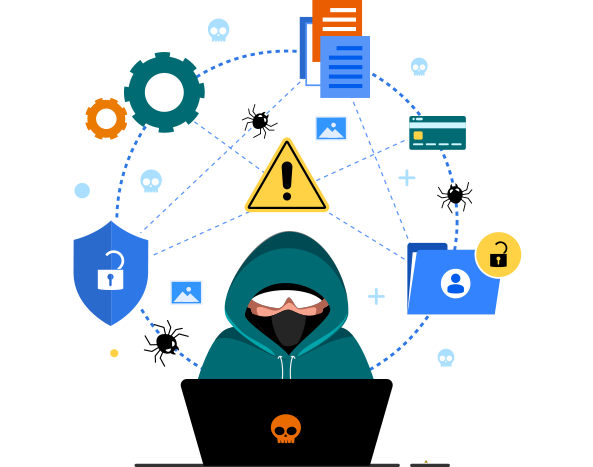Digital Risk Protection (DRP) Services in India
The threat landscape has rapidly evolved on social and digital platforms. As organizations look to remain competitive and keep pace with ongoing digital transformation initiatives, many are incorporating software, solutions and services to support these platforms. However, when organizations make these selections, they often don’t consider their exposure to new threats lurking in the shadows of their new digital frontier.
Today’s enterprise attack surface is not limited to the corporate network. In fact, the network is just a small slice. When it comes to deciding how and where to attack an enterprise, threat actors have ample opportunity beyond the network perimeter. As a result, enterprises are investing in operational capabilities to detect and respond to external threats across the digital risk landscape. This is Digital Risk Protection (DRP).
Digital risk protection (DRP) is the practice of protecting organizations from cyber threats during digital transformation.
Rather than reacting to cyber threats after they're discovered, cybersecurity strategies must shift to a proactive approach to protection. This is the key to supporting ecosystem expansion while mitigating risk.
Digital Risk Protection was developed to fill meet this desperate requirement, starting from social media channels and extending to all digital assets exposed to potential threats,
The most common use cases for DRP include:
- Disaster Recovery: Email backup and restore
- Compliance Ready: Long term storage & quick retrieval
- Email Monitoring: Corporate messaging surveillance
- Improved Server Performance: Offload processing and storage
- Reduce Administration & Helpdesk Costs
- Email Archival Reports: Business Intelligence


DRPS – Map, monitor and mitigate credible threats entering the public attack surface
DRP services provide 360° digital visibility, real-time threat detection and automated remediation, including the takedown of attacker infrastructure to discourage future attacks. From helping protect organizations from cyber, brand and physical threats to monitoring social media, domain registrations and the surface, deep and dark webs, effective Digital Risk Protection Services enable an organization to respond quickly to digital threats. What’s more, since many organizations struggle to monitor external, unregulated channels for risks (e.g., like social media and web channels), DRPS provide protection capabilities that other security solutions do not
Here are three reasons why security teams need DRPS :
1. Analysis of your entire digital footprint for threats
When it comes to DRPS, it is essential to remember that it’s not just about where to look but what to look for. Security teams must analyze data across their entire digital footprint as opposed to focusing solely on the channels or digital properties their organization owns. Understanding an organization’s portfolio of digital assets will allow security teams to swiftly detect and act on suspicious activity, like an account impersonation for a former employee.
DRPS provide organizations with the tools they need to analyze their entire digital footprint holistically. A superior DRPS platform includes features that allow security teams to discover and evaluate references to names, brands, accounts, sites, products, executives and employees associated with an organization. With these capabilities, organizations can analyze channels beyond their own and do the following:
1. Determine where a reference came from.
2. Find all external references to their brands, products and employees.
3. Investigate if the references are legitimate or signs of malicious activity.
4. Remediate credible threats before they compromise an organization’s reputation.


1. Complete coverage over a broad range of social and digital platforms
Today, almost every organization has made significant investments towards protecting their network, endpoints and services from attackers. However, despite the rise of digitization and prominence of social media platforms, many have not invested resources to protect digital platforms, like a company Twitter page or an Amazon marketplace listing. As a result, these platforms are prime targets for attackers, and when infiltrated, compromise a brand’s reputation and trust.
Well rounded Digital Risk Protection Services will not only cover an organization’s Facebook page or eBay store, but also offer security teams omnichannel visibility into the breadth of social and digital platforms comprising that organization’s attack surface. This includes coverage of social media platforms, employee credentials on the dark web, fraudulent domains and more. This expansive coverage, coupled with managed services support, lifts the weight off of security teams’ shoulders to manually monitor threats entering their organization’s digital footprint or manage multiple different technologies for different channels.
1. Stop attackers before broader damage is done
Some of the most impactful breaches are those that go unnoticed and untreated for an extended period of time. The real value of DRPS lies within its ability to stop an account hijacker in their tracks or shut down fraudulent behavior the second it appears within an organization’s digital footprint — before lasting damage is done. The best DRPS use cutting-edge SOAR platforms to automatically target and analyze threats entering an organization’s public attack surface - reducing time spent on manual security efforts. As a result, they have the ability to immediately take down credible threats without straining an organization’s security team.


Selecting the right DRP service
TThough several vendors offer DRP services, each approaches the domain with a unique perspective. Despite these differences, an organization's DRP service is capable of providing effective threat detection, analysis, and remediation with the following capabilities:
1. Automation and ease of management - effective DRPS should not cause additional stress over the amount of time and effort it takes to manage. DRPS should take tasks off of security teams to-do list, and not add them. Look for components like Cloud and mobile app functionality, integration with the most commonly used security tools and managed service support to ensure that a security team isn’t bogged down with intensive management efforts. Automated remediation and takedown are essential as well to reduce the impact of threats.
2. AI-based tools - To streamline the analysis of data produced by platforms like mobile app stores, social media platforms, and GitHub, AI capabilities are necessary. They quickly identify risky content by searching through millions of posts, images, and information available on public platforms — no matter how complicated those threats may be. Without AI to support a DRP service, organizations can be exposed to targeted cyberattacks, data loss, phishing scams, compliance violations or account takeovers.
3. Global threat intelligence and research - Favor DRP services that offer social and digital channel threat intelligence. Access to advisories, breaking news, and vulnerability chatter from these data sources can help organizations better prioritize threats and vulnerability management as threat conditions evolve.
Modern organizations require modern security solutions
Attackers are looking beyond network systems and devices to target organizations via public-facing platforms and SaaS resources. An effective DRP service will identify threats across an organization’s digital footprint, analyze the credibility of these threats and remediate malicious activity on third-party platforms to minimize system and reputational damage. Impersonators, fraudsters and threat actors are ready to attack. Now is the time for security teams to invest in reputable DRPS to defend their organization’s public attack surface from modern threats.

